When footballer David Beckham first talked about building a stadium in Miami for his Major League Soccer expansion team in February 2014, he appeared relaxed and confident. The first question posed to him in the press conference was, “Why did you choose Miami?” His answer: “I mean, why not?” Why not indeed, given that Miami’s government has had a history of building up city infrastructure at the beck and call of tourist dollars. His latest proposal has suggested filling in a deep-water boat slip along downtown Miami’s waterfront — the Florida East Coast Railway Slip — and building a 20,000-seat stadium on top. As a Miami native, I marveled at the fact that someone who has never lived in the city — someone who is essentially a tourist — could make these huge plans for it, thinking that because he was excited about them, Miami would follow his cue and be excited about them too. But like many before him, he has been lured by the illusion of accommodation and ease that exoticized, tropical places such as Miami seem to offer their visitors.
Beckham reminds me of a character in Our Man in Havana, one of Graham Greene’s novels set on various Caribbean islands. We experience Havana though the eyes of the narrator: myopic, prone to fantasy, a tourist’s eyes. And in the end, we don’t care that there is barely a semblance of reported truth in the stories. This to me is the darkest, most challenging aspect of Greene’s novels: the accusation that what we want out of seemingly faraway lands is for them to be blank, open spaces that we fill up with our fantasies.
Greene’s themes can easily describe Miami, where first-generation immigrants (from places like Cuba, Haiti, and South and Central America) and their children comprise the city, and where outsiders’ cultural perception of these immigrants’ home countries bleeds into the general conception of their adopted city. For the past few years, Miami’s tourists have predominantly come from large metropolitan areas in the U.S. (New York, Chicago, Philadelphia, Boston, and Atlanta are the top-ranking U.S. cities from which tourists have visited Miami since 1999); and in slightly smaller numbers from abroad, mostly from Latin America (last year, Latin Americans accounted for five million visitors to the city, versus Europe’s 1.3 million). Miami’s tourists are of the economic class of people who can afford to spend $1,000 or more on a long weekend.
These visitors have varied points of reference for what they would want out of their vacations. Tourists come to Miami Beach for anything from Hip-Hop Weekend (renamed Urban Beach Week), a festival that brings around 250,000 visitors per year to the city; to Art Basel, the international art festival; to a shopping spree at a local mall famous in Latin America as a place to stock up on goods you can’t get back home. The message about Miami’s culture — a culture that can attract all sorts of visitors — can only be described as no message at all. One New York Times travel piece from late last year summed it up: “Miami can be whatever you want it to be — laid back, decked out, gay, straight, a family recess, a single’s playground — which is precisely what makes it such an effortless getaway. In this dreamland at the southern tip of Miami Beach, you can choose your own adventure.”
What adventure should that be? And is there a real Miami? Undoubtedly many tourists go to Miami to immerse themselves in the commercial gloss and easy fun, and so they are content to have that fun at clubs in South Beach, at music festivals, at sports games. There is also another type of tourist, who is in one way culturally savvier, and in another way culturally more naïve, than his club-going, beach-lounging counterpart. This tourist goes to Miami expecting to find some traces of what might be considered “authentic” culture — perhaps a hideaway spot where he can drink tropical juice while watching old men play dominoes, or enjoy some home-cooking in a dingy restaurant in the neighborhood of Little Haiti — and is disappointed when these cultural artifacts are either hard to find or seem canned for tourists. I never even knew this particular tourist frustration existed until some New York-based friends would come back from a vacation to South Beach or a visit to Art Basel and complain that Miami was too touristy, too commercial.
A recent episode of Louie captures the fantasy of this authentic experience-hungry visitor. In the episode, Louie CK travels to Miami to perform in a comedy show. He has become bored with just lying on the beach and generally feels a malaise about his whole trip, when he is saved by a Cuban-American lifeguard who takes him to mainland Miami, to Little Havana, where, we are led to believe, Louie feels like he is experiencing “authentic” Miami. Louie develops a crush on the lifeguard and, as the lifeguard begins to pick up on Louie’s desperation, he closes himself and his “authentic” life off to Louie. The episode ends on a somber, uneasy note.
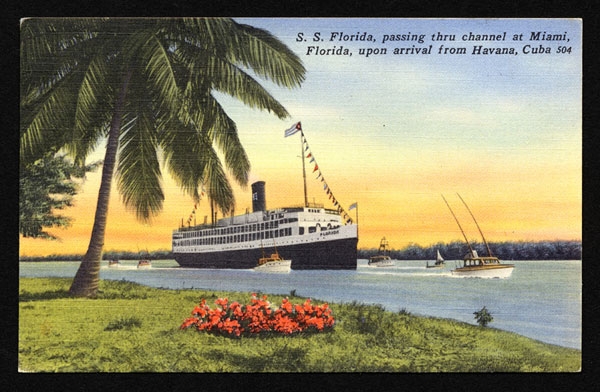
“S.S. Florida passing thru channel at Miami, Florida, upon arrival from Havana, Cuba: 504.” Image: The Wolfsonian Museum.
The concept of Miami as an “open city,” one that accommodates and molds itself according to the desires of tourists and various other visitors, is embedded in the city’s history. A young city by most measures (it was incorporated only in 1896), Miami grew because of its tourism industry, its bones fashioned and financed to attract high-end vacationers. The city’s first investor in large-scale infrastructure projects, Henry Flagler, was an industrialist-turned-hotel-magnate who spent the latter part of his life financing bridges, ports, and railways, putting his weight behind anything that would get more tourists to Miami and into his hotels. When Miami first became a popular tourist destination in the 1920s, it earned a seaport, financed in part with federal funds, as well as a waterfront park — Bayfront Park — that was financed by the city. Both of these projects were championed by the then-president of the Miami City Chamber of Commerce, Everest Sewell, who was obsessed with increasing tourism. (He was eventually elected mayor in 1927.) Both the port and the park were also ostensibly built in the public interest, for the enjoyment and profit of the city’s natives. It’s impossible to know how much Miamians enjoyed Bayfront Park when it was first built, but I can say that its recent life as a public space has been rather lackluster. While the park is lively during Urban Beach Week and other large festivals when concerts are being held there, on an average day, you’ll most likely find only litter — and no people.
Alongside this boom in public infrastructure, which extended into the 1950s, the business community in Miami was fashioning the city’s public image as a “Gateway to the Americas” (a variation of Pan American World Airways’ slogan for its investment in a two-story terminal in Miami in the 1930s), where tourists and businessmen from Latin America could go to experience a United States that was friendly to them. The social scientist Chanelle Rose writes about how Miami public officials in the 1950s actively promoted the appearance of increased Hispanicization of the city, long before the city even started to become largely Hispanic. Committees sponsored by the City Chamber of Commerce conducted studies designed to see what would attract Latin American tourists during the summer, then dreamed up festivals based on the ones in other ethnically diverse cities, like New Orleans’ Mardi Gras. Rose points to a tourist pamphlet from the 1940s titled Se Goza Mucho Más en Miami Beach — which characterized Miami as “the premier tourist center of the Americas” — as an example of a brochure that was meant to make Miami seem ethnically diverse and friendly for Hispanic tourists, whether that was the case or not.
While this idea of the city as a gateway — an in-between place — may have once been invented for tourists, it is now part of the city’s core. In some ways, the idea of being a gateway has been valuable for the city’s culture, allowing Miami’s immigrants — many of whom were forced to leave their countries under traumatic conditions — to practice and cultivate their own versions of their cultures in the city rather than assimilate. But another effect of thinking about your home city as a gateway is that it becomes difficult for you to think of it as a fertile place on its own. If Miami is a place for passing through, if the natives are always thinking about one day returning to their “real” homes, and if tourists do return home after a few days, why would anyone dedicate time to cultivating the grassroots foundations of Miami itself?
As David Beckham started lobbying in earnest for his stadium project in late May, the question of whether Miamians would just adopt another tourist’s conception of their city once again was at the fore. A few opposition groups formed to discuss environmental problems with filling in the old Railway Slip, and some groups of downtown residents opposed the project because it would block their views of the water. But Miamians were largely silent — there were neither large protests nor large demonstrations of support. In fact, there were no public discussions of the issue at all, save for a few comments in Miami Herald articles. (The Herald took a poll of public opinion and found it to be evenly split.) In the end, the most impassioned group was made up not of citizens concerned about the future of downtown Miami, but of a group of well-known architects and urban planners who wrote in a public statement that Beckham’s stadium “is not in harmony with the vision of Miami as a world-class city with parks and open areas available for all, for generations to come. We must protect the legacy envisioned by the people of Miami.”
In mid-June, the mayor of Miami, Tomás Regalado, shut down the proposal for the port site. Whether he was listening to his constituency, as he claims, or to various lobbyists, or to the group of architects and urbanists — or to a combination of the three — is impossible to know. But it sends an unusual message for Miami, showing the city to be inhospitable, hard to get. And it might be unfair to be happy that Beckham’s plans were rejected, because it’s possible that he had the best intentions for boosting the city’s economy. Yet I can’t help but see it as an opportunity for Miami to get out from under its real legacy: the weight of the tourism industry, which has both built up and oppressed the city. Miamians might truly like the idea of a soccer stadium in their city — it’s not unlikely, given a large number come from countries with strong soccer traditions — but if that’s what they want, they now have the opportunity to make Beckham work to provide them with the best option possible for them. The grassroots energy that this would require is foreign to the city, but if anything could help cultivate some idea of a “real” Miami, this would be it.
•
 Alexia Nader is a senior editor at The Brooklyn Quarterly and a freelance writer. She has contributed to the Los Angeles Review of Books, The Nation, and Oxford American, among other publications. She lives in San Francisco.
Alexia Nader is a senior editor at The Brooklyn Quarterly and a freelance writer. She has contributed to the Los Angeles Review of Books, The Nation, and Oxford American, among other publications. She lives in San Francisco.

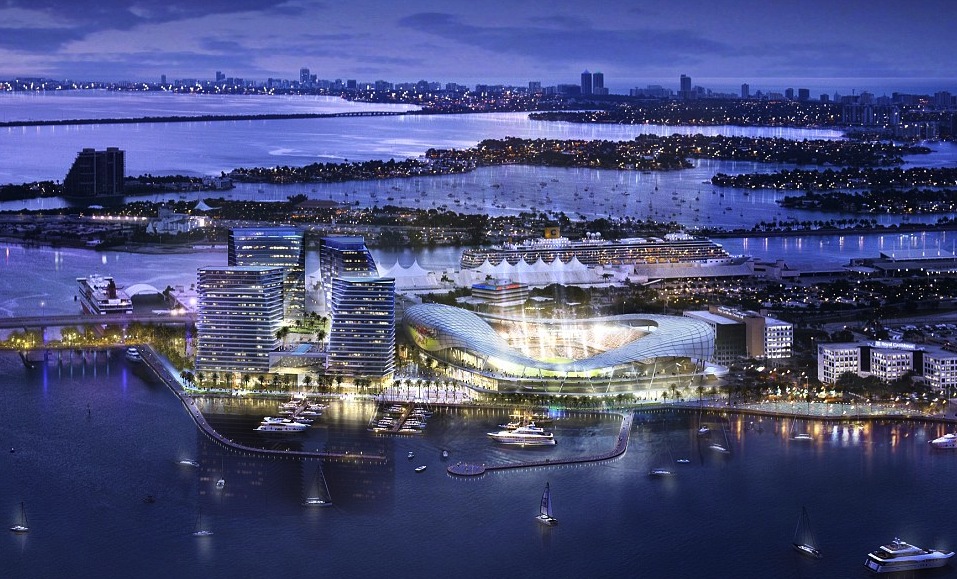
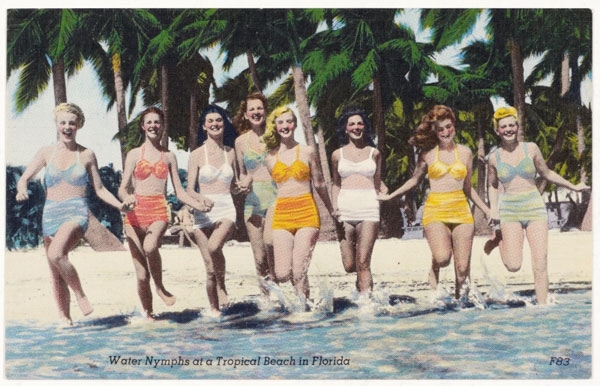
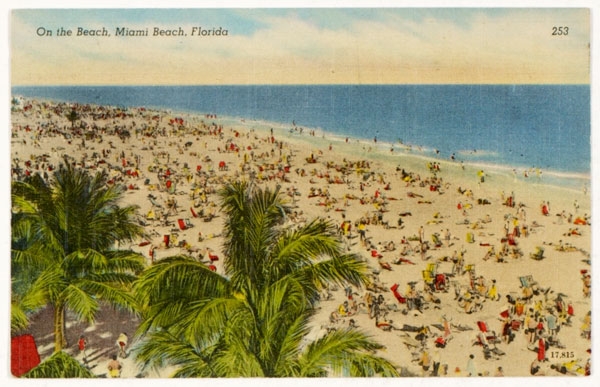
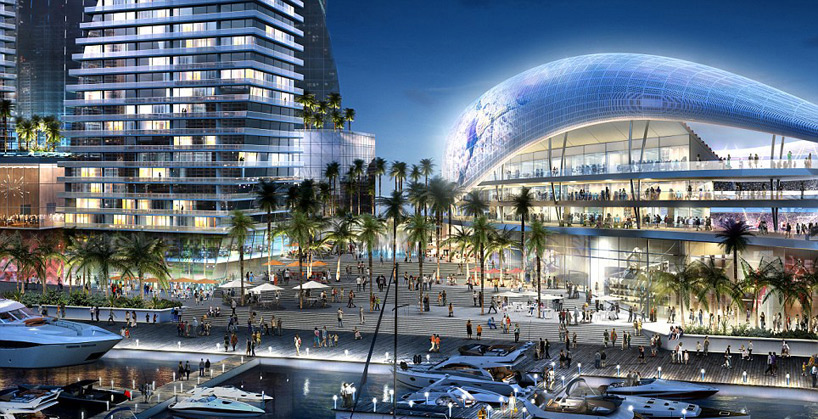
One thought on “Welcome to Miami, Beckham”